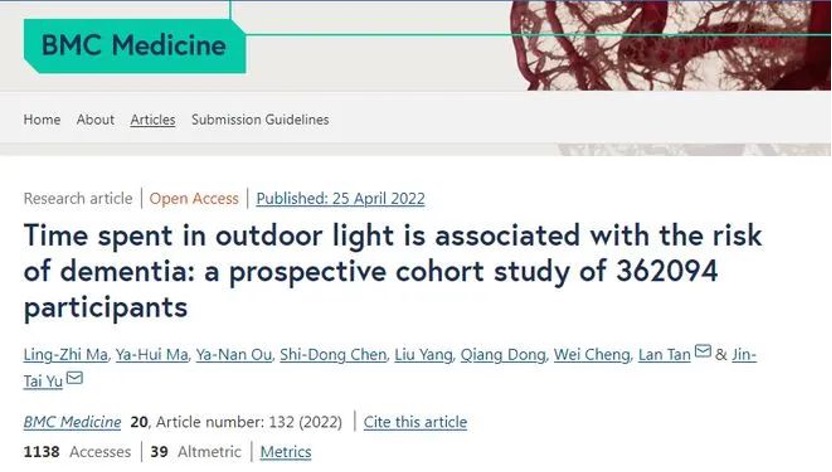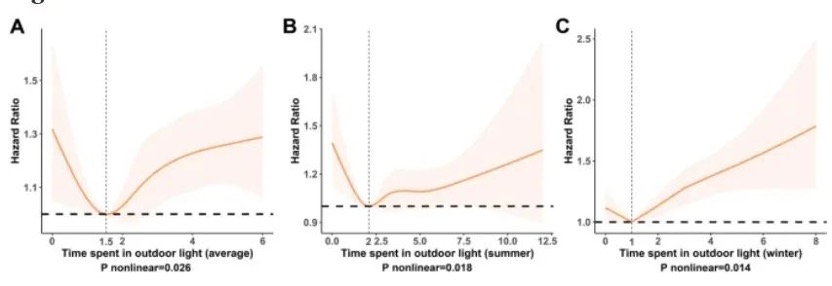Recently, Jintai Yu, Tianqiao and Chrissy Chen Institute Investigator and professor from Fudan University-affiliated Huashan Hospital and his team jointly published a paper titled “Time spent in outdoor light is associated with the risk of dementia: a prospective cohort study of 362094 participants” on BMC Medicine, in collaboration with Professor Lan Tan’s team from Qingdao Municipal Hospital which is affiliated with Qingdao University. The study, researching a cohort of over 360,000 people with a nine-year follow-up program, discovered that appropriate sunlight exposure is conducive to the control and prevention of dementia but only when the exposure time is strictly controlled within a reasonable range.

In modern society, people are getting increasingly less exposure to sunlight, usually replaced by bright artificial lighting throughout the day. Prior to Professor Jintai Yu’s study, there was no population-based cohort research that examined the correlation between outdoor natural light exposure and new cases of dementia.
Data for the study were from a cohort of 362,094 UK Biobank participants. A survey was conducted to investigate how many hours the participants spent outdoors on typical summer and winter days. A restricted cubic spline (RCS) was performed to explore the potential nonlinear relationship between sunlight exposure and the risk of dementia. The team used multivariate Cox proportional hazard regression models to estimate the hazard ratios (HRs) for the association between sunlight exposure and dementia outcomes, with the change points as a reference.

The Cox hazard regression models showed a marked increase in risk at low exposure (HR=1.287, 95%CI 1.094–1.515) but a relatively slow increase at higher exposure (HR=1.070, 95%CI 1.031–1.10). Results were more pronounced among participants over 60 years old, females, and those with exactly 7 hours of sleep every night.
The RCS showed a J-shaped relationship between time spent in outdoor light and the dementia risk, with the lowest risk at three change points (1.5 h/day on average, 2 h/day in summer, and 1 h/day in winter). A dose-dependent association between sunlight exposure time and the risk of dementia was not evident among participants under 60. In females, the dementia risk was lowest at around an average of 2 hours per day and increased dose-dependent if the time was below or above 2 hours per day. The subgroup analysis of sleep duration showed that even participants who slept 7 hours per night needed sunlight to reduce the risk of dementia, with the bottoms of the spline curve being about 1.5 hours per day. This value is 2 h/day in summer and 1 h/day in winter.
There may be a variety of mechanisms underlying the relationship between sunlight and cognitive decline. Studies have pointed out that vitamin D receptors are widely present in neurons and glial cells. Vitamin D is involved in a variety of crucial pathways for brain health, involving neurotransmission, neuroprotection, regulation of immune response, inhibition of pro-inflammatory agents, and regulation of oxidative stress. It is therefore reasonable to use sunlight exposure to represent an individual’s long-term vitamin D level. In addition to vitamin D status, environmental sunlight may also affect the physiological and cognitive functions of the human body by regulating the circadian rhythm and affecting the suprachiasmatic nuclei (SCN) which is also referred to as the body’s internal clock.
The article also mentions the consequences of excessive sunlight exposure including sunburn, skin cancer (melanoma, lip cancer, and keratinocytes), and eye disease (cataracts, ultraviolet keratitis). In conclusion, determining the optimal duration of sunlight exposure may have attached even more profound significance to this study.
